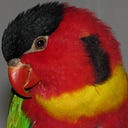The physics of structural plumage colours in birds
A look at the physics that underlie how birds grow coloured plumages, especially violet, blue and white feathers
This piece was included in the book, Open Laboratory 2007: The Best Science Blog Writing of 2007.
by GrrlScientist for The Guardian | @GrrlScientist

Most avian plumage colours are the result of different types of pigments that are deposited into feathers while they are regrowing after moult. However, pigments alone do not produce all avian feather colors. Blues, such as those seen in hyacinth macaws, Anodorhynchus hyacinthinus, and white, such as the snowy colour of Bali mynahs, Leucopsar rothschildi, typically result from small changes in feather structure that alters their light reflective properties. These fundamental modifications cause violet and blue light to be selectively reflected from the feather surface in the case of violet/blue feathers, while white feathers reflect all visible light. In short, violets, blues and whites are structural colors, or schemochromes.
Visible light is composed of many colours of light, each with distinct wavelengths. Red light, for example, has a long wavelength (~700nm) while violet and blue light (which I shall refer to as blue light throughout the remainder of this essay) has a much shorter wavelength (~400nm). When visible light encounters particles with the same or larger diameter than its component wavelengths, those specific light photons are reflected. For example, particles that are 400nm or slightly larger will selectively reflect blue light photons, while allowing other light photons to pass by. Some of these reflected light photons are collected and thus seen by an observer’s eye, thereby adding colour to the perceived image.
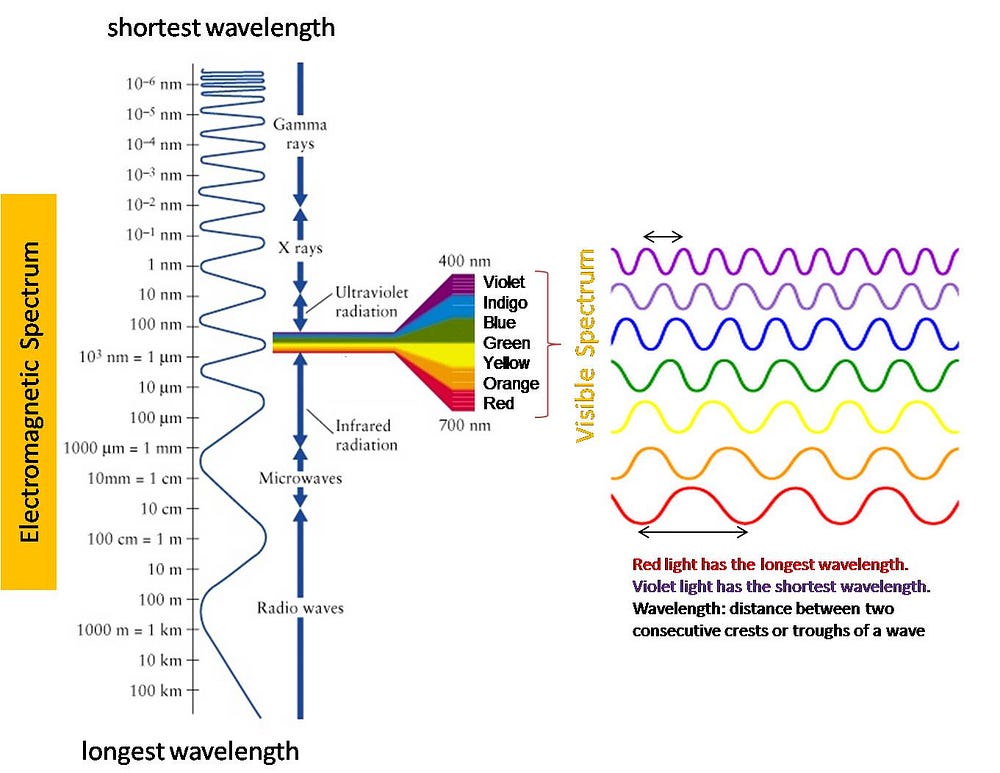
Because blue light has very short wavelengths, it is reflected more easily than other colours of light with longer wavelengths. This was first understood in 1869, when scientist John Tyndall noted that minuscule particles in earth’s atmosphere preferentially scattered blue light resulting in the familiar “sky blue” of a clear summer day. Shortly afterward, Lord Rayleigh (John William Strutt) demonstrated that Tyndall’s “fine particles” are actually individual gas molecules in Earth’s atmosphere, specifically, nitrogen and oxygen. In feathers, preferential scattering of light by small air cavities or keratin particles overlying a dark melanin layer results in blue coloring. The other colours of light are absorbed by the melanin layer, intensifying the colour. Blue plumage colour is often referred to as a “Tyndall blue” structural colour.
Tyndall scattering can be demonstrated at home using a simple experiment to produce a pale Tyndall blue colour. First, mix one or two drops of milk into a glass of water then place this glass in a dark room and focus a flashlight upon it. The fluid will appear bluish. This bluish colour results from blue light bouncing off milk particles suspended in the water while other, longer, light wavelengths pass unobstructed through the fluid. Of course, milk has some larger diameter particles in it that also reflect light wavelengths that are slightly longer than blue, thereby contaminating the pure “Tyndall” blue colour.
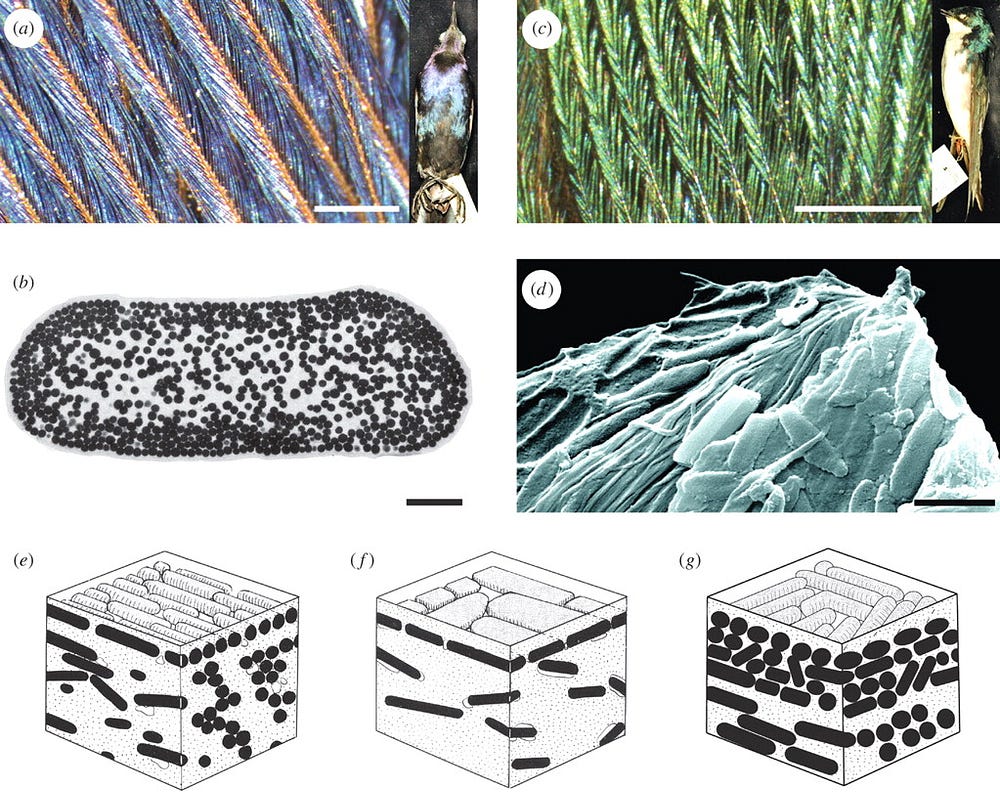
Like the above described milk experiment, blue colours in the plumage of most bird species result from preferential scattering of blue light by the feather structure itself. For example, when a blue feather is observed under a powerful microscope, the surface layer of keratin appears cloudy or milky due to the presence of small air cavities. Keratin is the proteinaceous connective tissue that feathers, hair and nails are comprised of. A cross-section of a feather reveals an underlying layer of melanin granules and tiny air pockets in the middle of the feather barb. These small air cavities act like tiny particles by selectively scattering blue light while dark-coloured melanin granules absorb longer wavelengths of light, intensifying the blue colour.
In contrast, structural differences are immediately obvious when a red feather, which derives its colour from red pigments, is viewed under the same microscope. The surface of a red feather is transparent and colourless while the underlying structures are filled with red pigment granules that reflect only red light.
Further, differences between structural and pigment colours can be easily demonstrated using several simple experiments. Because structural colour is entirely dependent upon reflective structure, a blue feather becomes dark when it is ground into a powder. However, a red or yellow feather will retain its original colour when subjected to the same treatment because the pigments are not damaged even though the feather structure was destroyed.
Pigments can also be removed, or “extracted”, from a feather. When a red or yellow feather is ground up and placed into an appropriate solvent, the pigment granules will dissolve into the solvent (doi:10.1007/s00265–004–0853-y). Interestingly, blue feathers can also lose their colouring when placed into certain types of liquids (you can also rub these liquids onto the surface of a feather instead of submerging it). However, this depends upon the liquid’s optical density instead of its ability to leach pigments out of the feather’s structure. One such liquid solvent, Cresol, causes a blue feather to become dark because it fills the air cavities that are inside the feather structure. Because Cresol has a refractive index that is nearly identical to that of keratin, it prevents reflection of blue light. However, Cresol doesn’t turn blue and, after the feather is dried, its lovely blue colour returns.
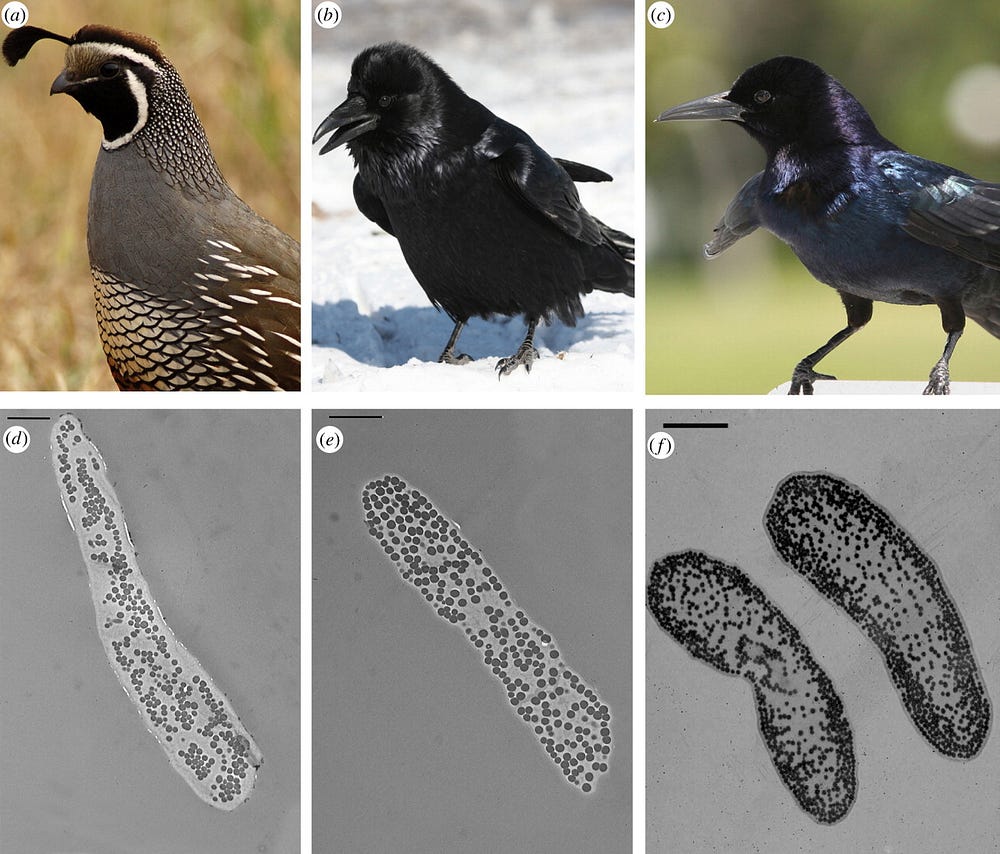

The physical phenomena that generate structural blue colours are similar, but not identical to, those that produce iridescent colours, such as those seen in magpies and on the head of a male mallard duck. Iridescent feathers get their colour from interference, which is due to waves of light interacting with each other to produce either constructive reinforcement or destructive cancellation of particular wavelengths, or colours.
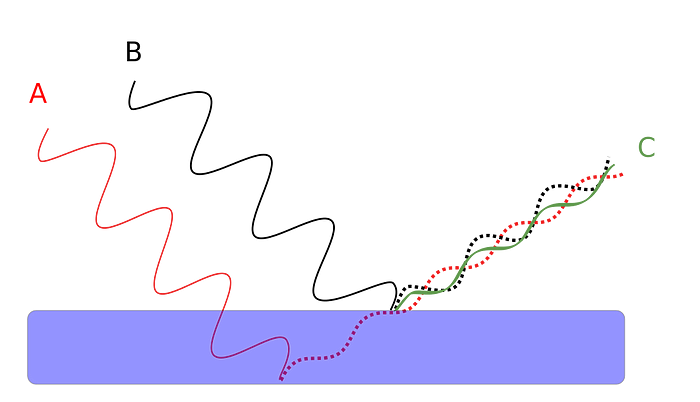
For example, even though oils are colourless, a thin film of oil on water produces a rainbow of brilliant colours due to this light interference phenomena. These colours are referred to as thin film interference colours. Similarly, iridescent feathers often appear to be very bright and colourful when compared to a structural blue feather viewed under the same light. But unlike iridescent feathers, blue feathers remain blue to the observer when the feather is rotated in relation to the light source whereas the colouring of iridescent feathers varies and then becomes black as the angle of the light shifts. But both iridescent and blue feathers will appear dark when placed directly between the light source and the observer because light cannot be reflected from the feather surface into the observer’s eye.
White plumage, such as that seen in the Bali mynah, Leucopsar rothschildi, is also a structural feather colour. White plumage relies upon the same principles as described for blue feathers, except white is produced when all wavelengths of light are reflected by the feather. A white feather also shows interesting structural characteristics when viewed under a powerful microscope. The surface structure of a white feather appears crystalline, resembling cut glass or snow — clearly capable of reflecting all visible light. White feathers also contain many air cavities in the feather barbs that increase the total reflection of all spectrums of visible light. As previously described, both melanin granules and air pockets are found in the middle of blue feathers; but predictably, white feathers lack melanin and they contain many more air cavities. This lack of underlying melanin granules can be easily demonstrated because a lustrous white feather becomes transparent when immersed in balsam.
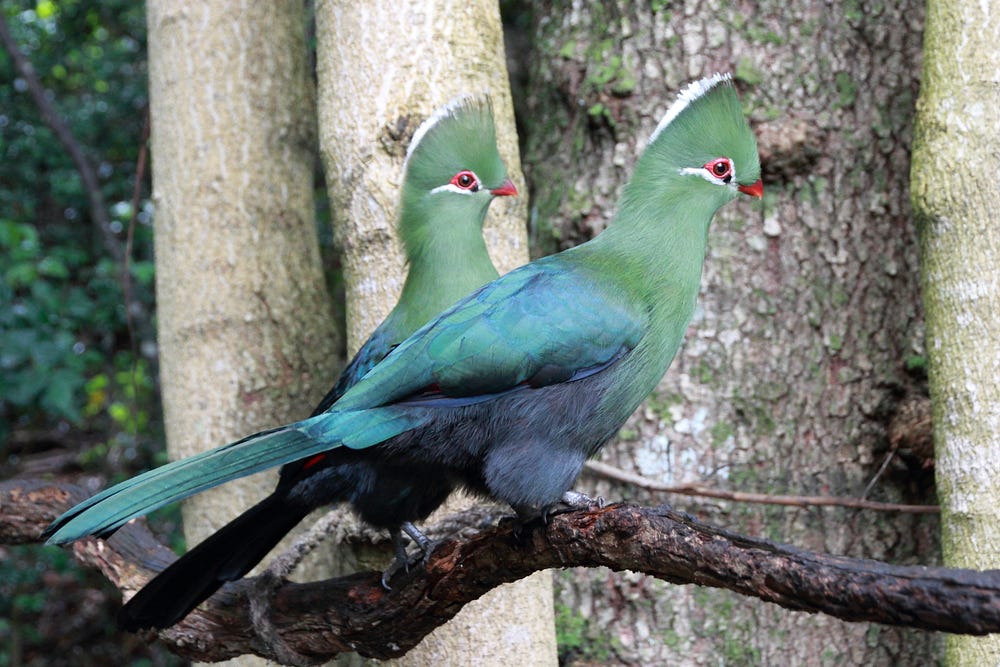
Unique among all bird families are the turacos (Family: Musophagidae) because they alone produce their own special green pigment, which is known as turacoverdin to honour these birds. All other bird species create green feathers through a combination of both structural and pigment colours. In a green bird, for example, the feather retains its blue-reflecting structures whilst embedded within its keratin structure are either yellow carotenoid pigments (producing pure bright greens) or yellow carotenoids combined with melanin pigments (producing darker olive greens). The ability to produce blue-reflecting feather structures and plumage pigments are genetically recessive traits, so they are only apparent when both copies of a particular colour gene are deactivated. Thus, it is possible to produce either blue, yellow or white plumage colour variants, or “morphs”, by breeding green parent birds. This happens when a bird experiences genetic deactivation or loss of its ability to either produce yellow pigments or to grow feathers with blue-reflecting structures, or both simultaneously — a fact that has provided thousands of bird breeders with many decades of pleasure.
Surprisingly, despite humanity’s deep appreciation for colours, especially violet and blue, there remain many questions yet to be answered about colours in animals. For example, why don’t birds routinely produce blue pigments? Why is blue such a rare colour in animals? What is the evolutionary significance underlying this general lack of blue pigments among birds and other animals?
Sources:
Richard O. Prum, Rodolfo H. Torres, Scott Williamson and Jan Dyck. (1998). Coherent light scattering by blue feather barbs, Nature 396:28–29 | doi:10.1038/23838 [PDF]
Kevin J. McGraw, Jocelyn Hudon, Geoffrey E. Hill, and Robert S. Parker. (2005). A simple and inexpensive chemical test for behavioral ecologists to determine the presence of carotenoid pigments in animal tissues, Behavioral Ecology and Sociobiology 57:391–397 | doi:10.1007/s00265–004–0853-y [PDF]
Jakob Vinther, Derek E. G. Briggs, Julia Clarke, Gerald Mayr, Richard O. Prum (2010). Structural coloration in a fossil feather, Biology Letters 6, 128–131 | doi:10.1098/rsbl.2009.0524
Rafael Maia, Liliana D’Alba, Matthew D. Shawkey (2011). What makes a feather shine? A nanostructural basis for glossy black colours in feathers, Proceedings of the Royal Society B, 278, 1973–1980 | doi:10.1098/rspb.2010.1637
.. .. .. .. .. .. .. .. .. .. .. .. .. .. .. .. .. .. .. .. .. .. .. .. .. .. .. .. .. .. .. .. .. .. .. .. .. .. .. .. .. .. ..
NOTE: I originally wrote this long-form piece when I was an ornithology postdoctoral fellow at the AMNH, several years before I republished it on The Guardian. I had been inspired by my Master Birder instructor, ornithologist Dennis Paulson, then-Director of the Slater Museum of Natural History at the University of Puget Sound, who several years earlier had asked my Master Birder class to write an essay: “Why don’t birds produce blue feather pigments?” He knew this question had no answer, but we did not. Even after writing the original (much shorter) essay, I was unable to get this question out of my mind, so I continued to research this topic on my own and this (much longer) piece is the result.
Enjoy my writing? Please give me a few handclaps to recommend this piece. Follow me on Medium for more like this.
.. .. .. .. .. .. .. .. .. .. .. .. .. .. .. .. .. .. .. .. .. .. .. .. .. .. .. .. .. .. .. .. .. .. .. .. .. .. .. .. .. .. ..
GrrlScientist is very active on twitter @GrrlScientist and you can follow all her writing by subscribing to her TinyLetter
Republished at The Guardian on 16 October 2007.

